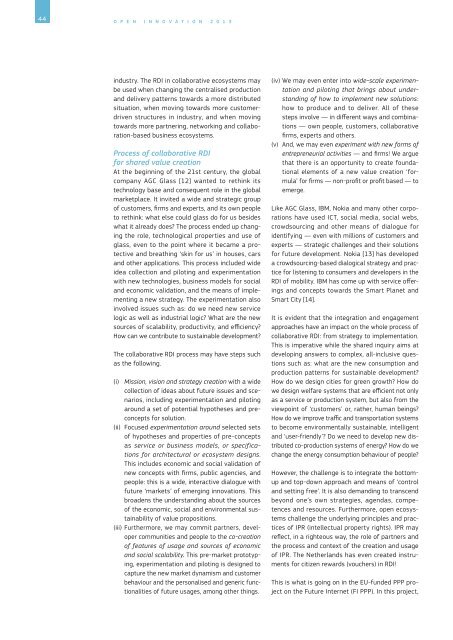Open Innovation 2.0 Yearbook 2013 - European Commission - Europa
Open Innovation 2.0 Yearbook 2013 - European Commission - Europa
Open Innovation 2.0 Yearbook 2013 - European Commission - Europa
Create successful ePaper yourself
Turn your PDF publications into a flip-book with our unique Google optimized e-Paper software.
44 O P E N I N N O V A T I O N 2 0 1 3<br />
industry. The RDI in collaborative ecosystems may<br />
be used when changing the centralised production<br />
and delivery patterns towards a more distributed<br />
situation, when moving towards more customerdriven<br />
structures in industry, and when moving<br />
towards more partnering, networking and collaboration-based<br />
business ecosystems.<br />
Process of collaborative RDI<br />
for shared value creation<br />
At the beginning of the 21st century, the global<br />
company AGC Glass [12] wanted to rethink its<br />
technology base and consequent role in the global<br />
marketplace. It invited a wide and strategic group<br />
of customers, firms and experts, and its own people<br />
to rethink: what else could glass do for us besides<br />
what it already does? The process ended up changing<br />
the role, technological properties and use of<br />
glass, even to the point where it became a protective<br />
and breathing ‘skin for us’ in houses, cars<br />
and other applications. This process included wide<br />
idea collection and piloting and experimentation<br />
with new technologies, business models for social<br />
and economic validation, and the means of implementing<br />
a new strategy. The experimentation also<br />
involved issues such as: do we need new service<br />
logic as well as industrial logic? What are the new<br />
sources of scalability, productivity, and efficiency?<br />
How can we contribute to sustainable development?<br />
The collaborative RDI process may have steps such<br />
as the following.<br />
(i) Mission, vision and strategy creation with a wide<br />
collection of ideas about future issues and scenarios,<br />
including experimentation and piloting<br />
around a set of potential hypotheses and preconcepts<br />
for solution.<br />
(ii) Focused experimentation around selected sets<br />
of hypotheses and properties of pre-concepts<br />
as service or business models, or specifications<br />
for architectural or ecosystem designs.<br />
This includes economic and social validation of<br />
new concepts with firms, public agencies, and<br />
people: this is a wide, interactive dialogue with<br />
future ‘markets’ of emerging innovations. This<br />
broadens the understanding about the sources<br />
of the economic, social and environmental sustainability<br />
of value propositions.<br />
(iii) Furthermore, we may commit partners, developer<br />
communities and people to the co-creation<br />
of features of usage and sources of economic<br />
and social scalability. This pre-market prototyping,<br />
experimentation and piloting is designed to<br />
capture the new market dynamism and customer<br />
behaviour and the personalised and generic functionalities<br />
of future usages, among other things.<br />
(iv) We may even enter into wide-scale experimentation<br />
and piloting that brings about understanding<br />
of how to implement new solutions:<br />
how to produce and to deliver. All of these<br />
steps involve — in different ways and combinations<br />
— own people, customers, collaborative<br />
firms, experts and others.<br />
(v) And, we may even experiment with new forms of<br />
entrepreneurial activities — and firms! We argue<br />
that there is an opportunity to create foundational<br />
elements of a new value creation ‘formula’<br />
for firms — non-profit or profit based — to<br />
emerge.<br />
Like AGC Glass, IBM, Nokia and many other corporations<br />
have used ICT, social media, social webs,<br />
crowdsourcing and other means of dialogue for<br />
identifying — even with millions of customers and<br />
experts — strategic challenges and their solutions<br />
for future development. Nokia [13] has developed<br />
a crowdsourcing-based dialogical strategy and practice<br />
for listening to consumers and developers in the<br />
RDI of mobility. IBM has come up with service offerings<br />
and concepts towards the Smart Planet and<br />
Smart City [14].<br />
It is evident that the integration and engagement<br />
approaches have an impact on the whole process of<br />
collaborative RDI: from strategy to implementation.<br />
This is imperative while the shared inquiry aims at<br />
developing answers to complex, all-inclusive questions<br />
such as: what are the new consumption and<br />
production patterns for sustainable development?<br />
How do we design cities for green growth? How do<br />
we design welfare systems that are efficient not only<br />
as a service or production system, but also from the<br />
viewpoint of ‘customers’ or, rather, human beings?<br />
How do we improve traffic and transportation systems<br />
to become environmentally sustainable, intelligent<br />
and ‘user-friendly’? Do we need to develop new distributed<br />
co-production systems of energy? How do we<br />
change the energy consumption behaviour of people?<br />
However, the challenge is to integrate the bottomup<br />
and top-down approach and means of ‘control<br />
and setting free’. It is also demanding to transcend<br />
beyond one’s own strategies, agendas, competences<br />
and resources. Furthermore, open ecosystems<br />
challenge the underlying principles and practices<br />
of IPR (intellectual property rights). IPR may<br />
reflect, in a righteous way, the role of partners and<br />
the process and context of the creation and usage<br />
of IPR. The Netherlands has even created instruments<br />
for citizen rewards (vouchers) in RDI!<br />
This is what is going on in the EU-funded PPP project<br />
on the Future Internet (FI PPP). In this project,
















